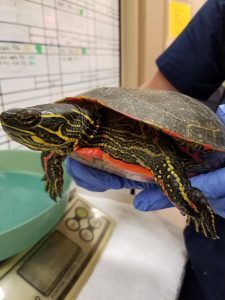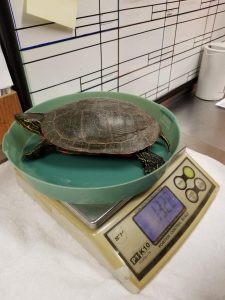Support Us
Since 1979 more than 140,000 animals have been treated by Wildlife Rescue.
Thanks to the support of individuals like you, Wildlife Rescue can provide a lifeline for animals in distress.
The stunning Western Painted Turtle, Chrysemys picta bellii, is named for its bright yellow stripes on the head, neck, tail, and legs and beautiful red on the shell (carapace) and belly (plaston). Painted Turtles have webbed hind feet and slender claws on their front feet that can grow over a foot long!

The Western Painted Turtle is the only native pond turtle left in BC. Currently, they are blue-listed which means they are sensitive to human disturbances and natural occurrences. They are considered vulnerable to habitat loss and are susceptible to human and natural disturbances. Habitat loss is a result of increased pollution, waterway interference because of dams, agriculture, and urbanization of waterfronts.
Painted Turtles prefer lakes and ponds, ditches, sluggish streams with muddy bottom and aquatic plants. These areas play a vital role to provide food sources, basking, shelter from predators and hibernation.
When the temperature starts to warm up and the ice melts, Painted turtles leave the water to find a suitable mate for courtship. The courting activities last less than twenty minutes and involves a chase. The male seeks a single female turtle slowly passing in front of her and approaching her head-on with his legs stretched open. If this entices the female turtle, she will follow the male into the pond to mate.

The female works hard to find a proper nesting location for her eggs and builds the nest between dawn and dusk. Female Painted Turtles seek out open and south-facing sites with loose soil without plants, roots, and rocks. Preferred sites for nesting are about 150 cm away from the water. Once the location is located the female uses the strength in her legs to dig up and loosen the soil and places her eggs and then covers them with debris from potential predators like skunks, raccoons, and human disturbances.
The survival of these hatchlings is low due to freezing and predator attacks. Females only reproduce 1 batch of eggs every two years, providing a low reproductive rate of juvenile painted turtles.
In early May, a Western Painted Turtle arrived at Wildlife Rescue from a local resident in Surrey, BC. This turtle was picked up while crossing a busy street and brought to our hospital. A thorough examination by our hospital manager Janelle indicated signs of dehydration and no injuries were detected. After some rehydration and food, the Western Painted Turtle was released back to the water closest to where it was found.

If you come across a turtle, it may just need to be moved out of the road. Call the Wildlife Support Centre if you need help to determine if it needs rescuing. If it is, please be sure to wear gloves to prevent any transfer of disease between the human and turtle.

Wildlife Rescue encourages the public to learn how to handle wildlife before picking anything up and asking for help when needed. Had the finder not picked this turtle up, it could have easily been a victim of a car strike. The goal of the organization is to release healthy animals back to their native environments. Wildlife Rescue strives to provide education including ways to support co-existing with wildlife in the face of growing urbanization.
If you would like to learn more about the work we do please visit our website here, contact our Support Centre or provide care to an animal in care Donate here!